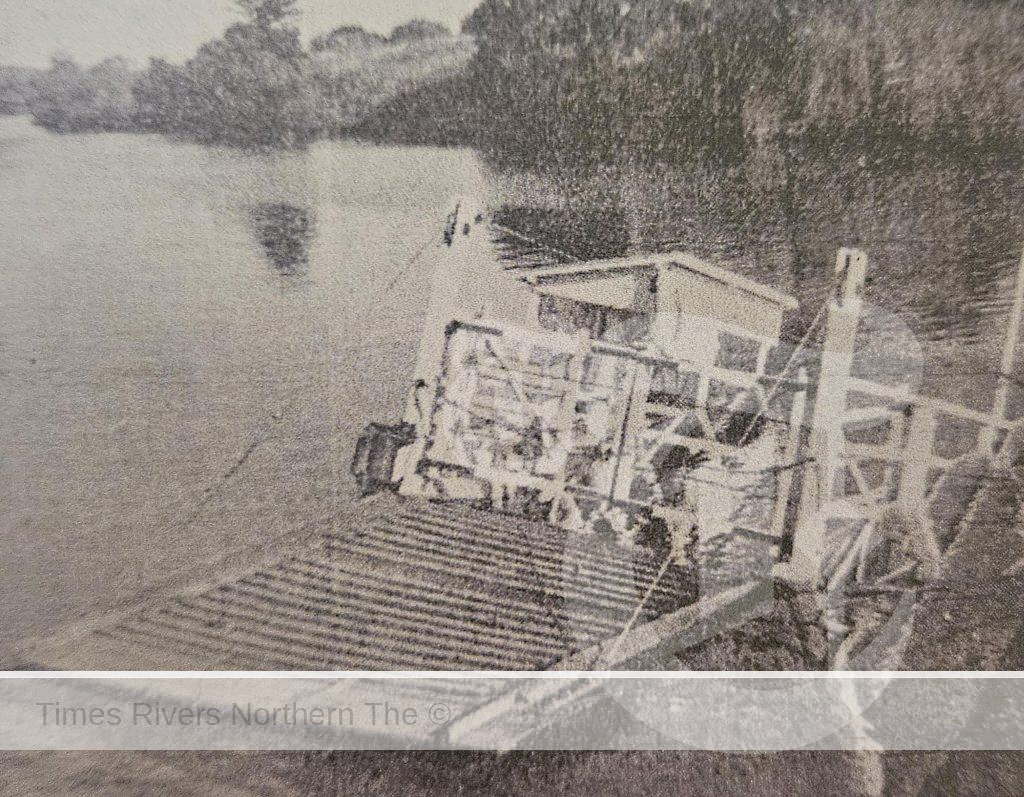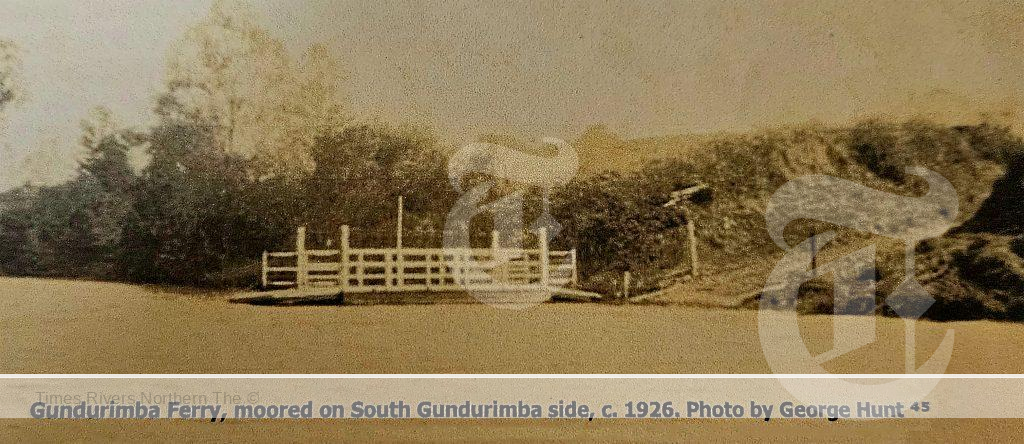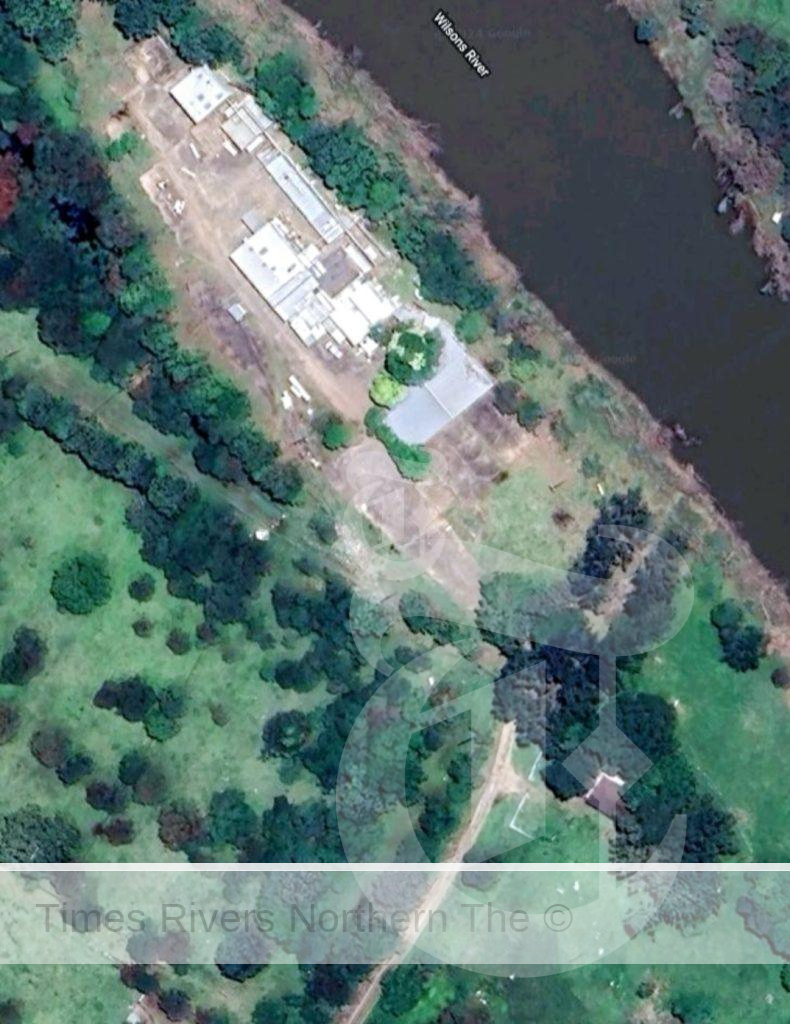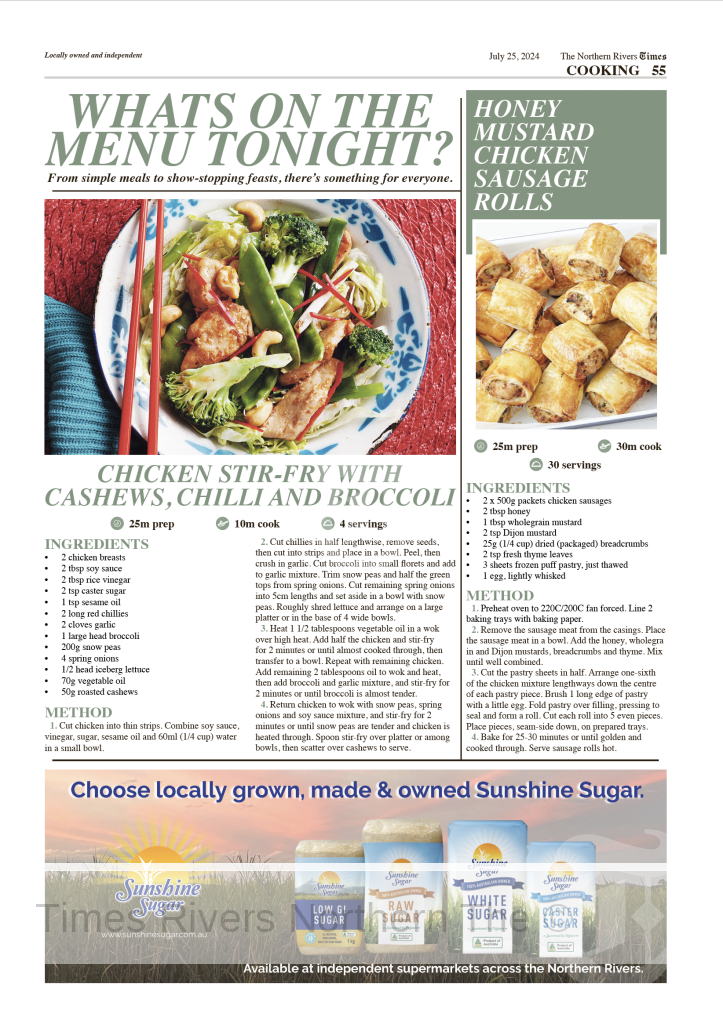GUNDURIMBA FERRY
By Helen Trustum
Five kilometres down the river from Lismore’s Ballina Street Bridge boat ramp, rounding a sharpe though wide bend, creates the pointing promontory named Sandy Point. At the southern end of the now abandoned meat works, is a cut into the steep western bank ending at a concrete ramp where the Gundurimba Ferry would pull in. On the opposite side of the river is farmland featuring a gentle sweeping cut with dressed stones visible at low tide. These approaches on either side bear the words “Beware Submarine Cable” are the remains of the Gundurimba Ferry.
Gundurimba played an early role in the British invasion of the Wilsons River. Cedar getters first established themselves in 1842 at Codrington, soon after at Wyrallah. When a severe drought hit in 1843, the loggers were attracted to the “well grassed plain” and tree filled ridges at Gundurimba. They soon set up camp on both sides of the river. The town of Gundurimba was proclaimed in 1859, three years after Lismore.

Gundurimba Ferry
By 1871, Gundurimba had a population of 202 on both sides of the river. There were several shops, a hotel, post office, school, shipwright, horse riding track, a Church of England and a slaughter yard. The same year the residents petitioned the Government for a ferry to be established, to no avail. Then in 1885 they tried again for a ferry at Gundurimba. Finally in 1887 the punt was officially proclaimed a government ferry. The fares were set the same as other ferries in the district.
For every foot passenger – twopence
For every horse, mare, mule drawing or not drawing – sixpence
For every gig, dray or cart – 1 shilling
For every wagon, dray or vehicle with four wheels – 1 shilling & sixpence
For every ox or head of cattle – threepence
For every sheep, lamb, pig or goat – 1 shilling & twopence

Gundurimba Ferry – 1926
Gundurimba now had their own ferry. The connection between Gundurimba and South Gundurimba was secured. On 1st January 1902, all 88 hand operated ferries in the eastern districts of NSW were transferred to the newly formed shires. The Gundurimba ferry became the responsibility of the newly formed Gundurimba Shire Council. Shortly afterwards the Government abolished ferry tolls, except between 11pm and 6am. The night toll was established in 1924.
For its entire existence until 1961, the Gundurimba Ferry was hand operated. Getting the ferryman’s attention was not easy. The ferry was generally moored on the eastern side near the cottage. During the 1950’s, on the South Gundurimba side of the river, a ploughshare with a large bolt tied to a rope, was used to get the ferryman’s attention with a load clanging noise.

Bindaree Abattoirs showing ferry approach.
A constant danger to the ferry were ships travelling up and down the river. Vessels would have to give four whistle blasts above Sandy Point to signal their approach. It soon became clearer that the west side ferry approach was too steep. It was fine for people on foot and on horse, yet a gravel surface was required. In February 1936, Harry Seed was taking a load of pigs across the river to the Lismore Saleyards. The vehicle’s front wheels made it on the bank, but the rear wheels pushed the ferry back and they became imbedded in the mud. After unloading the pigs, another lorry came from Lismore to pull the truck out.
By 1960, it was decided to close the ferry due to costs and traffic decline. In May 1961, the ferry sank, due to a major hull failure. The local Government approved the closure on 14th July 1961.
Ferry Drivers – Benjamin Edwards,
MEMORIES
John Cooper: Referring to a letter by 81 year old John Cooper from Tomki, Casino in the Richmond River Herald dated 31st July 1936, it stated that his father was the first man to take up land on the North Arm. He secured 12 acres on the southern side of the river near the Gundurimba Ferry and where the Abattoirs stood. Looking at a map there is S M Cooper mentioned, right on the bend of the river near the ferry.
John Goodwin: We lived across the highway in South Gundurimba. My sister rode her bike and travelled across the ferry to school.
Robert Hayes: I worked with the livestock carrier of a Thursday of each week picking up calves around Coffee Camp and West Nimbin. They would then be taken to Fredericks Abattoirs. I think Hutleys were there from 1964 -65.
Luke Patch: I remember Steve Harmon doing all the welding and fitting when it was rebuilt.
Robert Maxwell: I worked at the Binadaree Abattoirs during the 1980’s as a stockman. I remember planting all those gum trees that grace the driveway as you drive in. I can remember seeing the ferry approach, it was very visible at the time right next door to the abattoir.
Jim Pearce: I spent a lot of time growing up with my maternal grandparents Ben and Doris Edwards at Gundurimba. Earliest memory is centered on the ferryman’s cottage which was occupied by my Grandparents around 1948. Aunty Lou Edwards was the Postmistress. An important job for the ferryman was to drop the ferry cable to allow passage of the ocean going vessels, “Wyangarie” or “Wyrallah” to pass on their way to Lismore.
Mike Hooke: I worked at the Abattoirs.
Elizabeth Benetti: Back in 1940-41, my Dad was the Health Inspector for the Municapality of Lismore also a Meat Inspector. His job was working with the Shires, inspecting the Slaughter Houses in the area. I went with Dad before school to all these places. We went to Fredericks and Hutleys who supplied butchers, Jackson and Ward and several other butchers in Lismore.
Brian Jarvis: My Dad Bob Jarvis worked for Jack Fredericks – early 1950’s to 1955.
Edna Small: I attended the Gundurimba Public School between 1943 and 1947. The teachers at the time were Mr Massey and Mr McCrohan. There were several families of children from South Gundurimba that travelled across the ferry each day to attend school. I remember Miss Edwards and from memory a Mr Edwards ran the ferry. It was a busy little community, with a school, hall and a tennis court.
Peter Fitness: I came to Lismore from Sydney just before Christmas 1953, to work in the family butchering business, owned by my mother’s brother, J.C. (Jack) and A.K. (Keith) Fredericks. I lived in South Gundurimba with my Uncle Keith and Aunt Elsie, until I was married in May 1960. We lived right above the Gundurimba ferry approach, so it was very much a part of our lives at that time. The ferryman was George Willis, who lived with his wife and family in a cottage on the eastern approach.
My Uncle owned a paddock on Gundurimba Road, an extension of Keen Street and we had to dip the cattle every three weeks, meaning we had to take ourselves and our horses across the river. We usually left home quite early so, to save us waking him up, George would bring the ferry over to our side, secure it, then row his boat back home. Being the junior member of the group, I usually had the job of winding the handle that propelled the ferry, which I didn’t mind, as it was all a new experience for me. Sometimes we would take cattle across, as the ferry had two sets of gates, the inner set forming a pen in the middle of the ferry, which could hold six to eight head. I’m not sure when the ferry finally finished, I think it was during a flood in the early 1960’s, but it was before Ballina Street Bridge was opened in September 1963. We then had to go through Lismore to access the paddock, which we did, loading the horses on a small truck.
I commenced working in the family slaughter yards, adjacent to the ferry approach in January 1954. It was a typical, small country yards, extremely primitive by modern standards, involving much hard labour. We would only kill eight or ten a day, starting at 5am, the rest of the day was spent working around the paddocks. This included fencing etc. My Uncles also bred racehorses. I often spent time ploughing, using a grey Ferguson tractor, planting lucerne, eventually harvesting it, stacking it in a big shed and finally chaffing it using a tractor and belt driven chaff cutter.
In 1956, we built a new, much more modern (for the time) abattoir, with electric winches and saws. This was added to over the years, including refrigerated cool rooms and a loading dock which could accommodate semitrailers. In 1988 we sold the abattoir to John McDonald, who traded as Yolarno, in Casino. He changed the name to Bindaree Beef. By this time, I had two sons, David and Tim, working with me. Davd and I left the business in 1990. Tim stayed on in quality control until the McDonald Family sold it to Casino Abattoirs several years later. It has had a chequered history since then, and now lies seemingly abandoned with coral trees blocking the view from the main road.
Ref: Parts taken from article “Crossing the River at Gundurimba” by Rob Garbutt printed in Richmond River Historical Bulletin November 2021.
Also, great help from Peter Fitness, Wyrallah.
For more rural news, click here.





 Tweed Shire News2 years ago
Tweed Shire News2 years ago
 Motoring News1 year ago
Motoring News1 year ago
 COVID-19 Northern Rivers News3 years ago
COVID-19 Northern Rivers News3 years ago
 COVID-19 Northern Rivers News3 years ago
COVID-19 Northern Rivers News3 years ago
 Northern Rivers Local News3 years ago
Northern Rivers Local News3 years ago
 Health News3 years ago
Health News3 years ago
 COVID-19 Northern Rivers News3 years ago
COVID-19 Northern Rivers News3 years ago
 NSW Breaking News3 years ago
NSW Breaking News3 years ago



























